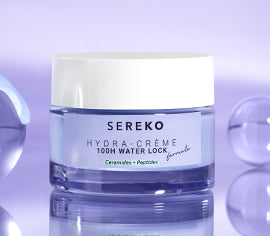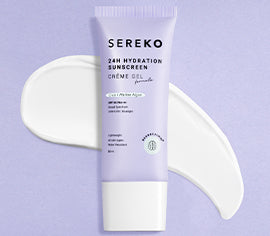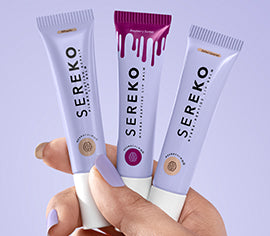There’s a special kind of frustration in looking in the mirror and realizing your skin can’t make up its mind — oily one moment, flaking the next. That layer of shine on your forehead doesn’t always mean hydration; sometimes, it’s your skin’s dehydrated cry for help.
Believe it or not, oily skin can also be dry. In fact, this paradox — oily but dry skin, dry oily skin, dry and oily skin at the same time — is far more common than we think.
The skincare-obsessed Koreans even coined a term for it: “Soobooji” (soo = water, boo = oil, ji = skin). It’s the kind of skin that looks oily on the outside but feels tight, flaky, and thirsty underneath.
So if you’re asking yourself, “Can oily skin be dry?” — the answer is an emphatic yes. Let’s decode why your skin feels this confused and what it’s really trying to tell you.
The Skin That Feels Torn Between Two Worlds
If your T-zone (forehead, nose, and chin) looks slick while your cheeks feel papery and dull — you’re dealing with combination skin, one of the most common skin types in India.
This imbalance often shows up when your skin barrier feels stripped — the invisible wall that keeps moisture in and pollutants out. When this barrier gets disrupted (thanks to over-exfoliation, actives overdose, or harsh cleansers), your skin loses water through a process called TEWL — Trans-Epidermal Water Loss.
When this happens, your skin goes into panic mode:
💧 "I'm losing water."
🛢️ "Let's make more oil to protect myself."
Well, here comes the cycle again: skin looks oily but feels dry.
Why Skin Is Sending You Mixed Messages
1. Overuse of Actives and Cleansers
We have all been here: you see a social media post about a serum or exfoliant and feel compelled to try it thinking it will "fix" your skin. But too much active ingredient can strip skin of its natural oils making it dehydrated, which makes your skin produce more oil in response — hence the annoying dry/oily skin texture.
2. Environmental Stressors
Pollution, heat, air conditioning can break apart the skin barrier. Humidity triggers oil production, while indoor cooling sucks out moisture — your skin can’t seem to find its balance.
3. Stress and Hormonal Imbalance
Mind and skin are more connected than we give them credit for. When stress hormones like cortisol rise, your oil glands go into overdrive. Add lack of sleep or anxiety to the mix, and your skin’s ability to retain moisture declines — resulting in oily and dry skin at the same time.
4. Using the Wrong Products
The issue can sometimes be found on your skincare shelf. Toners that are alcohol-heavy, foaming cleansers, or mattifying creams can create short-term dryness on the surface, which may push your skin to compensate with more oil.
How to Rebalance Oily But Dry Skin
The solution isn’t about “mattifying” or “hydrating” alone — it’s about repairing balance. Your skin doesn’t need punishment; it needs patience. Here's how to get it back home:
1. Go for Gentle Cleansing
Choose gentle, non-stripping cleansers that cleanse the skin without dehydrating the barrier. Look for a formula with a humectant like glycerin or panthenol that adds and keeps moisture while dissolving excess oils.
2. Hydrate Before You Moisturize
Layer hydration the same way you layer your thoughts — slowly and with intention. Start with a hydrating toner or essence (look for hyaluronic acid or beta-glucan) that hydrates your skin's deeper layers prior to sealing everything in with a moisturizer.
3. Meet Your Match - The Oil Clear Moisturizer
If your skin is struggling to choose between oily and dry, you may have a solution for it in Sereko's Oil Clear Moisturizer.
It's lightweight and yet still provides moisture - a product oriented towards combination skin - hydrates where your skin is dry and regulates where you are oily. With its non-comedogenic texture and hydrating ingredients boost hydration, it helps restore the skin barrier without a greasy feel afterwards.
It’s not just another moisturizer — it’s your skin’s quiet reassurance that balance is possible.
(Explore it here → Oil Clear Moisturizer)
4. Don’t Skip Sunscreen
Dehydrated skin is extra vulnerable to UV damage. Opt for a broad-spectrum sunscreen that is non-greasy and non-comedogenic so that it won’t block your pores but will protect against further loss moisture from your barrier.
5. Simplify. Then Stay Consistent.
Your skin doesn’t need a ten-step ritual — it needs a mindful one. Cut down on aggressive actives, let your skin breathe, and focus on hydration and protection. The objective is not perfection; it's balance.
Mind-First Reminder: Your Skin Mirrors Your Internal Weather.
At times, your dry oily skin is responding not only to skin products but also in direct correlation to your mental outlook.
When you’re stressed, your body prioritizes survival, not hydration. Your nervous system signals your oil glands to protect, while your barrier cells slow down regeneration.
Take a pause.
Drink water.
Sleep without guilt.
Touch your skin kindly — not as a critic, but as a caretaker.
The more balanced your mind, the more balanced your skin becomes.
And the Bottom Line is:
Next time you question “Why is my oily skin suddenly dry and flaky?” or “Can skin be oily and dry at the same time?” — know that your skin isn’t confused. It’s communicating imbalance.
With the right care — gentle cleansing, hydration layering, barrier repair, and the right product support like Sereko’s Oil Clear Moisturizer — your skin can relearn balance.
Because your skin doesn’t just need products.
It needs permission to heal — slowly, mindfully, and in its own rhythm.



